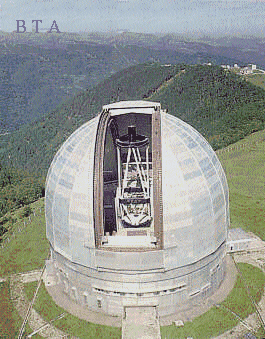6m telescope
The 6-m alt/az mounted telescope (BTA - Big Telescope Alt-azimuth) is the
largest optical telescope in Eurasia. Special Astrophysical Observatory
RAS provides continual operation of the telescope on requests of both
Russian and foreign scientists.
Scientific equipment necessary for
astrophysical observations is made and designed by the staff of the
observatory. The telescope is located near Mt.Pastukhova at the
altitude of 2070 m above sea-level. The co-ordinates of the site are
longitude 41o26'30",
latitude +43o 39'12".

|
|
Main mirror diameter |
6.05 m |
|
Focal length |
24 m |
|
Light collecting area |
25.1 sq.m |
|
Wavelength range |
0.3 - 10 mkm |
|
Angular resolution |
0.6 arcsec |
Angular resolution with the application
of speckle interferometry techniques |
0.02 arcsec |
|
Mass of the main mirror |
42 tons |
|
Total telescope mass |
850 tons |
|
Telescope height |
42 m |
|
Dome height |
53 m |
|
Optical scheme of the telescope
The main mirror (MM) is parabolic in shape and has a focal length of
24 meters. Its diameter is 605 cm. The diameter of the cylindrical prime
focus cage is 2 meters. Some removable optical devices together with the
drive mechanisms for the movements of the lens corrector and the hyperbolic
secondary mirror are located here. Laboratory tests have shown that 90%
of the energy is concentrated within a circle of 0.8" in diameter.
The image diameter is determined by the micro-climate in the dome,
as well as the thermal state of the mirror. Under favorable conditions
(small temperature difference between the MM, and the air inside the
dome and outside it), the size of stellar images is limited by atmospheric
turbulence.
The optical scheme of the telescope guarantees working at the prime focus
(f/4) and also at two Nasmyth foci (f/30). The time required to switch
the beam from one focus to another is 3-4 minutes,
which makes it possible to carry out observations on various focal distances
within a single night.
Any questions to
webmaster
Last update: 09/08/2012
|
|


